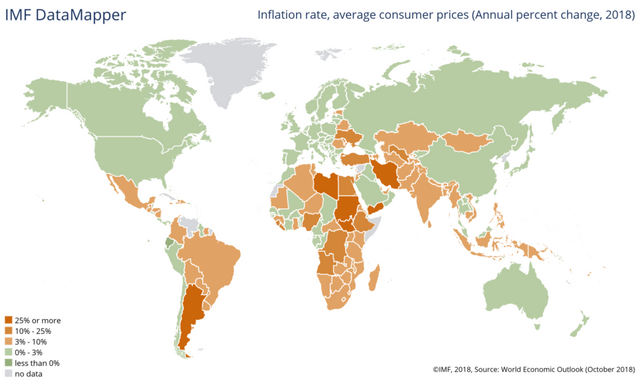Draper’s Bullish Prediction: $250k Bitcoin by 2022

Speaking at the Web Summit in Dublin, Tim Draper reaffirmed his earlier statement that the price of bitcoin will reach $250,000. He believes this threshold will be attained either by 2022 or 2023. The price of bitcoin has dropped by about ten percent since I began writing this article a few hours ago. Nevertheless, let’s look at the reasoning put forward by Mr. Draper.
Mr. Draper cites several major drivers for this climb which can be further classified into two groups.
- Typical Libertarian Arguments:
- Inflation inherent to the fiat currencies (flight to quality).
- General mistrust of the centralized government-issued currencies.
- Economic Arguments
- Bitcoin needs to capture just five percent of the fiat market to reach this level.
- Eventually, globalization will force the world to agree on a single global currency which naturally is going to be bitcoin.
- Major institutional players will have to start buying large quantities of BTC since in the future if they’ll want to acquire or invest in major crypto companies (he cites Coinbase as an example), the only way will be through BTC because those companies will not accept “political currency”.
- Mass adoption of bitcoin for everyday microtransactions.
- Governments will be forced to make crypto friendlier regulations to avoid capital flight and brain drain.
Inflation
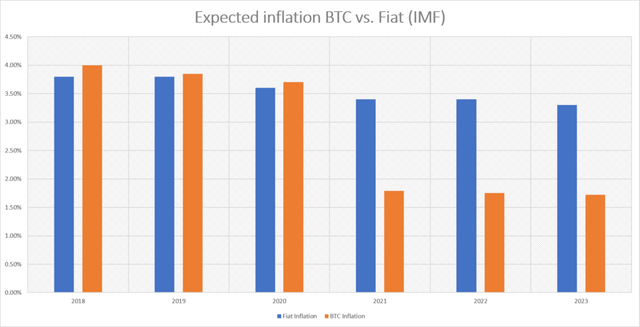
Expected Inflation: BTC versus Fiat.It is true that barring extraordinary economic situations, fiat currencies tend to be inflationary. For the developed economies, the healthy level of inflation is around two percent. We can see that the expected inflation for bitcoin and the aggregate of “political currencies” for the next couple of years is almost identical. Only in the year 2021, we expect to see a gap develop between the two.
Inflation Map.However, that aggregate number is heavily skewed by the developed economies who tend to have lower inflation and larger money supply. Nonetheless, there are quite a few countries around the world for which inflation is a real problem (See “Inflation Map”).
On the other hand, bitcoin inflation estimates are based on the total supply, i.e., every bitcoin that had ever been mined; yet it is believed that about four million had been lost, thus decreasing the real supply. Once we take this into account, there is little difference between the two examples.
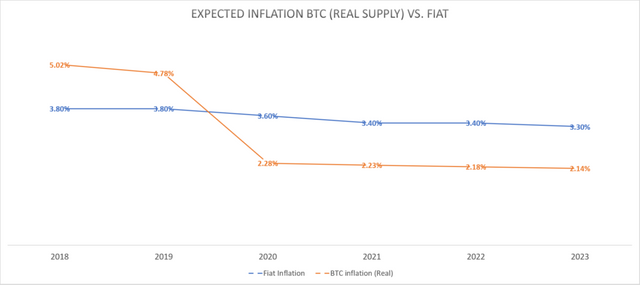
Expected Inflation: BTC (based on real supply) versus Fiat.Thus we might conclude that Mr. Draper’s argument doesn’t hold. However, the real advantage that bitcoin’s flavor of inflation has over fiat is that it is mathematically predetermined and will not waiver barring some cataclysmic events. And one doesn’t need to be a libertarian or belong to the Austrian school to agree that the unanticipated inflation is the real enemy of the state. However, we cannot seriously consider this argument until the bitcoin becomes true medium of exchange and we stop caring about the dollar conversion rate. Until then, in the eyes of the most investors, its high volatility will overshadow any advantages it may offer in terms of the predictable inflation.
NAY
Distrust of Central Authority
Whether the mistrust of central authority is gaining momentum is much harder to quantify. For instance, Edelman Trust Barometer has been noticing a general trend towards mistrust, in particular in the U.S., but this can be discounted by the Trump effect. I’ll leave this one alone as it is too subjective.
Five Percent
For bitcoin to reach $250,000 by 2022 its market cap needs to be only 3.38% of the expected fiat total circulating supply (M1 and M2) and to reach the same target by 2023, only 3.33%. Those are even lower numbers than the five percent postulated by Mr. Draper… Still, Mr. Draper as an experienced venture capitalist knows that it is a big no-go for an aspiring entrepreneur when pitching his idea to an investor to claim that “if only we can capture one percent of that huge market, we’ll make billions of dollars”. Just because the pie is big, doesn’t mean you can capture a small slice.
NAY
Globalization
There’s no denying that the globalization has been one of the major driving forces in the economic and political spheres over the past several decades. Although more recently, we have experienced an ebb in this trend, still it’s impossible to discount it long-term. In our transition to the planetary civilization, this would be a logical move. And the idea for one global currency is not as outrageous as it may sound. Several governments have already given up on their own sovereign currencies and have instead been relying on the U.S. dollar or another stable fiat currency as its legal tender. However, those are typically small and underdeveloped nations which do not have the resources to implement their own monetary policy.
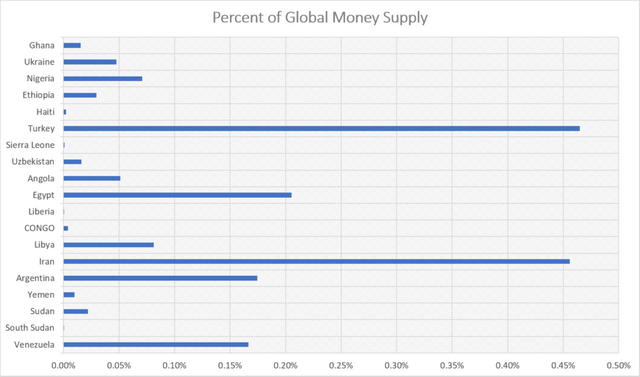
Money Supply of Countries with a Double Digit Inflation in 2018 as Percentage of the Global Money Supply.
Let’s assume that all the countries that in 2018 experienced a double-digit inflation decided to switch to the bitcoin as their national currency - in total, they represent just 1.82 percent of the total money mass. Clearly, it is not enough. We would need larger more developed countries to follow suit. In addition to the phantasmagorical nature of, for instance, Australia (1.66 percent) switching to bitcoin, even switching to another fiat currency that the country doesn’t control presents major challenges.
For example, when a country joins a Eurozone, it surrenders one of the two pillars of economic policy - monetary policy. Italy would is a good case to explore. Furthermore, the world’s most important economy, USA would lose many of the advantages it enjoys because of the dollar’s preeminent role in the world’s economy. The U.S. national debt is $21 trillion (exactly 100,000 dollars for every bitcoin that will ever be minted), in 2018 the interest payment will amount to $310 billion. This would not be sustainable under the bitcoin regime.
Moreover, there have been quite a few reports about one country or another introducing a sovereign cryptocurrency. However, it’s always about a centralized cryptocurrency, it’s just a variation of electronic money already being used by central banks.
It is dubious that any major country will accept bitcoin as its national currency by 2023.
NAY
Bitcoin Mass Adoption
Satoshi himself admitted in 2010, that bitcoin is not suitable for microtransactions. It was true then, it is even more so, now. The Bitcoin network cannot handle the high transactional volume. Perhaps, in the future, someone will come up with another side chain to solve this problem. Anyways, one doesn’t chip a piece from a gold bar to pay for a cup of coffee.
There are other cryptocurrencies and blockchain protocols that are better designed for this purpose. Their adoption will help bitcoin. As long as any cryptocurrency becomes widely accepted by merchants, by association, the bitcoin becomes a medium of exchange. For this to happen, quite a few stars need to align. Regulation around the world needs to be streamlined, bigger better stable coins need to emerge, and the reputation of the crypto niche in the eyes of the mainstream must improve.
There will be a much greater adoption of cryptocurrency by 2022/3, but whether it will be big enough to push bitcoin to $250,000 is uncertain.
MAYBE
Institutional Players
We have been hearing about the institutional players joining the party en masse for a long time now; however, I haven’t encountered yet the argument that Mr. Draper propounds: in the future, large crypto companies (Coinbase) will like to receive investments in bitcoin or another cryptocurrency, thus the institutional players should start piling it up before it becomes prohibitively expensive. In the world, where cryptocurrency rules, certainly, this will hold true. But until then… This argument depends on the convergence of all the other factors.
When Coinbase acquired Earn.com it didn’t pay with bitcoins, when it received a $300 million investment, it did not ask for bitcoins.
The more realistic involvement of major institutional players may be caused by the demand from their wealth management clients as well as the desire to hold “digital gold” long term. The latter motif may be shared by central banks.
It’s hard to imagine institutional players not being heavily vested in crypto five years from now.
YEA
Government Regulation
Businesses gravitate toward the countries which make doing business easy and profitable. This includes the rule of law, political stability, corruption, the cost of labor, taxation etc. All governments are naturally interested in attracting foreign direct investment as it creates jobs, increases the tax base and overall quality of life. The legal uncertainty is one of the major hindrances to the growth of the crypto industry.
In many jurisdictions, crypto companies struggle to open bank accounts, are subject to unfavorable tax regimes and are faced with uncertain tomorrow. It’s no coincidence, that the countries that have introduced crypto friendly frameworks (Singapore - although it may be reversing, Malta, Switzerland) have become major crypto hubs. Sooner or later, their neighbors will take notice. Even within the United States, the state of Wyoming strives to become a safe harbor for crypto businesses. There is no doubt, that over the course of the next few years many more countries (and states) will introduce similar initiatives.
YEA
Summing It Up
2 Yeas, 1 Maybe and 3 Nays.
For bitcoin to reach the $250,000 mark by 2023 it would have to undergo 208 percent annual growth. To reach the same mark by 2022 - 250 percent. As we are almost one year deep into the bear market, this seems highly unlikely, but one thing all of us should have learned by now is that predicting the price of bitcoin is even a more futile pursuit than the search for the real Satoshi, just ask Mike Novogratz.
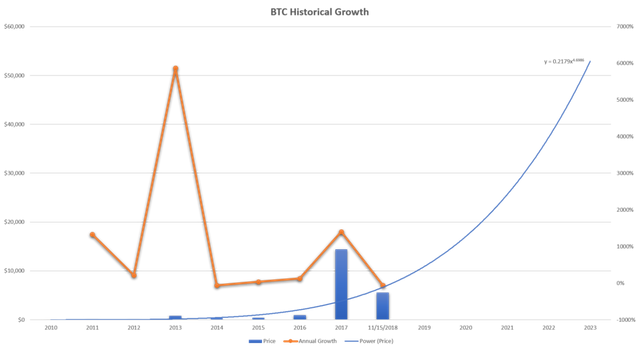
Bitcoin Historical Growth with Power Trend Line.
Tim Draper's Response and His Previous Predictions
We reached out to Mr. Draper for comment. His response: "Looks fine, but doesn’t recognize that my earlier prediction was right on the money".Back in 2014, in an interview with Fox Business, Mr. Draper predicted the price of bitcoin reaching $10,000 in three years (the current price was $413). He went on to purchase $30,000 bitcoins in the U.S. Marshals Service auction at about $600, he has added to his holdings since. In his recent talk at the Web Summit, Mr. Draper admitted that his long-term predictions seem to be more accurate than the short-term ones. Let's hope he'll be right again.
Originally posted on Crypto Insider : https://cryptoinsider.com/drapers-bullish-prediction-250k-bitcoin-by-2022/
